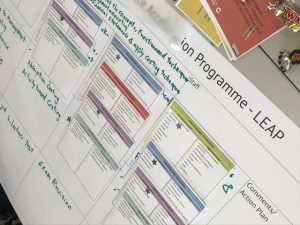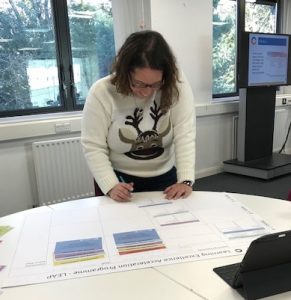Last week, we formally launched the new Learning Excellence Acceleration Programme (LEAP) with three workshops for staff on the Talbot campus. LEAP is a process that generates a visual representation of the structure, learning types, activities and assessment on a unit. Once complete, the visualisation can be used for unit development, reviewing the level of blending in the unit and also utilised as a component in programme review and revalidation exercises. Staff can find more information on the I drive at i:\CEL\Public\LEAP.
The feedback from the three sessions was very positive with staff highlighting how the visual representation allowed the key aspects of the unit to be quickly compiled and how the process provided a common language for talking about the unit structure which formed a good foundation from which to explore opportunities for development both at the unit and programme levels.
In the New Year, the plan is to broaden the roll-out of LEAP with both general and department/programme specific workshops.
If you would like more information on how LEAP might be able to help you, please contact David Biggins.
Some pictures from the sessions follow.
Diogo Montalvao from FST working on the representation of his unit. This early stage in the process asks staff to write down the unit ILOs and then to outline the topics covered in each week/session.

Debbie Holley supporting colleagues with the LEAP process. One of the strengths of the process is that it encourages us a academic staff to ask both how we engage students in their learning journey and what activities we can use to best support that journey.

This shows a partially completed LEAP worksheet. The weekly topic outlines have been augmented with the learning types that are most appropriate. The different coloured cards represent different learning types that are being used each week on the unit and the stars represent assessments (silver for formative and gold for summative). The worksheet contains the unit’s ILOS so that the mapping of activities to ILOs can be seen.

Shelley Thompson, CEL Theme Leader for Assessment and Feedback provided excellent advice on how the assessment layer in the LEAP process provides a way for staff to represent their formative and summative assessment structure and to use this representation for developing assessment on their units.

Geli Roushan facilitating a debate with colleagues from Law on the uses of LEAP.









